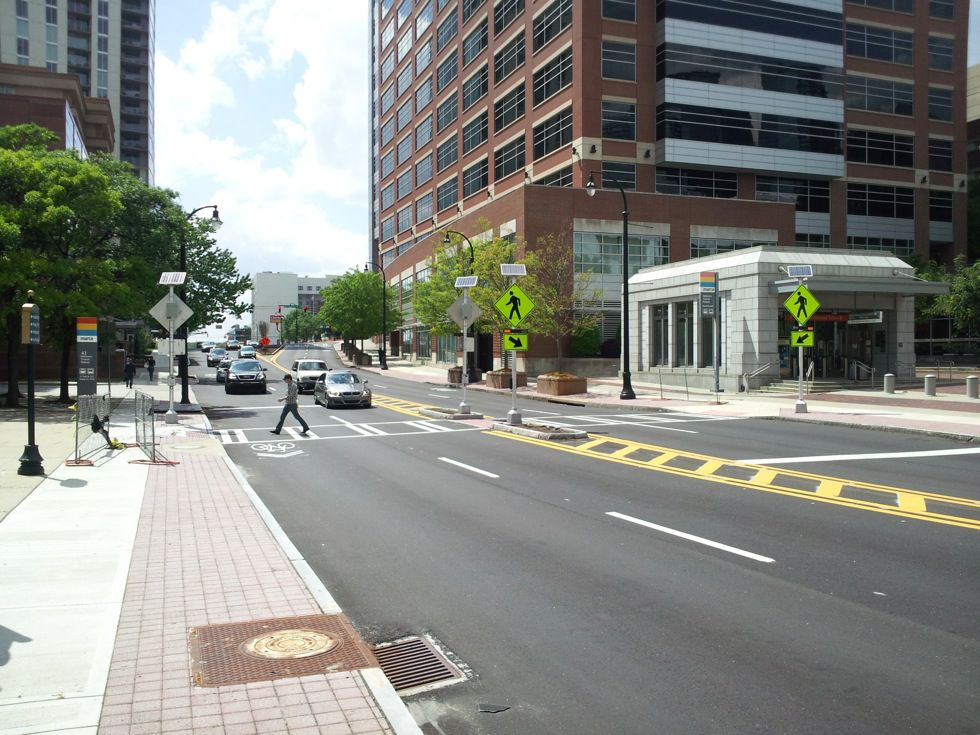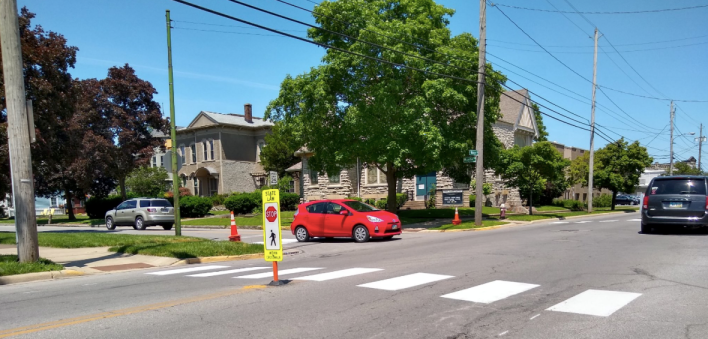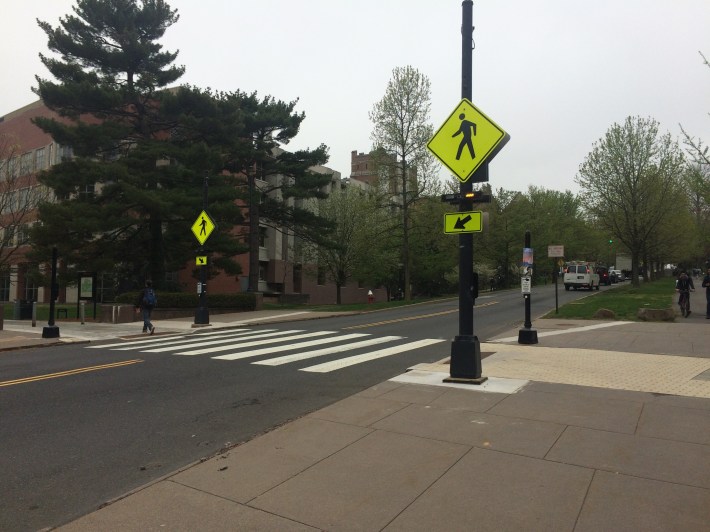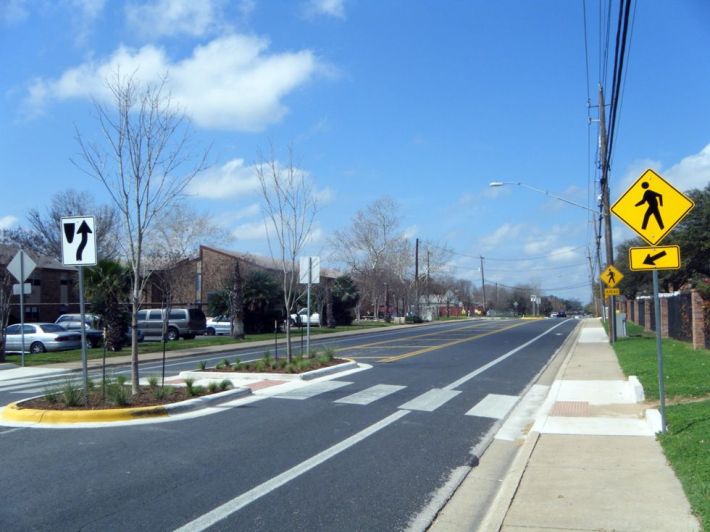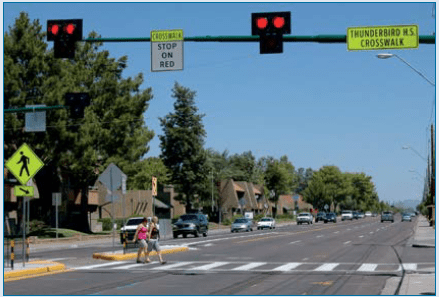Pedestrians deserve a safe places to cross the street. But a mid-block crossing with just some paint isn't going to cut it.
Various studies have found compliance rates between 16 and 32 percent for drivers yielding to pedestrians — as required by law — at crosswalks that don't have a traffic light or stop sign. In a word: terrible.
We're in the midst of a pedestrian safety crisis, with deaths soaring to more than 6,000 a year. It's time to rethink and improve the mid-block crossing. After all, almost three in four pedestrians who are killed were crossing at mid-block.
Fortunately, there are some good, low-cost innovations cities can use to make that safer. Below, we've highlighted some cheap, effective upgrades for mid-block crossings, listed in order from lowest-cost to most substantial.
Signs within a crosswalk
Those little yellow "State Law Stop for Pedestrian" signs that sit right in the middle of the street are technically called R1-6 signs. They're cheap and easy. But they shouldn't be underestimated. They work.
A research team at the University of Minnesota tested these last year at a handful of unsignalized intersections in St. Paul — and yielding increased significantly. Such signs work even better if multiples are installed, both in the center of the lane and on the outside, researcher Nichole Morris found. This is called a "gateway treatment."
These start at around $65 on the internet. But they are prone to damage and require a small budget to replace them every now and then. But that's a small price to pay to protect people from getting killed.
Cities should be installing these everywhere. Some of the most progressive cities are already doing so. Brookline, Massachusetts, for example, has installed 50.
Rapid Flashing Beacon
That is a fancy word for flashing lights that warn drivers a pedestrian is trying to cross the street. They require pedestrians to press a button when they are waiting to cross.
My anecdotal experience with this has been surprisingly good.
Scientific data that supports their wider use as well. The Federal Highway Administration reports this treatment been shown to reduce pedestrian-car crashes 47 percent, A St. Petersburg, Florida, study cited by the local ABC affiliate found they improved driver yielding by an astounding 85 percent.
Unfortunately, the federal government has only issued "interim approval" to these devices for frustrating reasons. The group in charge of signals and signs is slow to change, even in the face of mounting safety problems.
But cities can still install these helpful treatments, it just requires a little extra paperwork.
They can be especially helpful where bike trails cross roads or by schools. The median cost to install, according to FHWA was about $14,000.
Raised Crosswalks
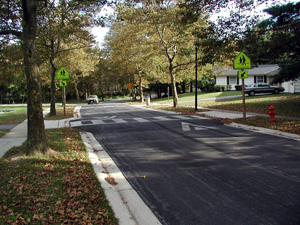
One of the best ways to make a mid-block crosswalk safer is simply lift it off the ground. Raised crosswalks are perfect for making pedestrians safer because they literally force drivers to slow down.
According to the Institute for Transportation Engineers [PDF], speed humps slow vehicles to about 20 mph, just the right speed for mixing with pedestrians.
A 2008 study by the Federal Highway Administration found these reduced vehicle-pedestrian crashes by 46 percent.
Raised crosswalk are elevated three to 3.5 inches off the ground and they plateau at the top for about 10 feet.
Some cities — *cough cough,* Cleveland — complain they don't work well with snow plows. But this is a bad excuse for just leaving pedestrians to get killed or injured in the street. New York City has tens of thousands of intersection. It has started a minuscule program that has resulted in about a dozen raised crossings.
Refuge islands
A great way to upgrade a mid-block crossing is to pour some concrete right in the middle and make pedestrians a refuge from traffic.
Pedestrian refuge islands make crossing "easier and safer" for pedestrians, according to the National Association for City Transportation Officials, "because they reduce the exposure time experienced by a pedestrian in the intersection."
They can also be landscaped to look beautiful and they encourage drivers to slow down because they create an obstacle in the middle of the road.
Hawk Signals
Some places, particularly Arizona, have begun installing HAWK — or Pedestrian Hybrid Beacons — signals. These operate like traffic lights, but they are used mid block specifically for pedestrian protection.
HAWK signs are activated by a button.
There's good support for their safety benefits. The Federal Highway Administration says these have been shown to reduce pedestrian crashes 69 percent and overall crashes 19 percent.
The federal government has some perverse rules about this, requiring a pretty enormous amount of pedestrian traffic before one is "warranted" by engineering manuals. And they can also be expensive.
But on wider, higher-speed roads where a mid-block crossing is important, they can be really effective.
National Editor Angie Schmitt is working on a book about the startling rise in pedestrian deaths nationwide. The still-untitled Island Press book is expected out next year.
